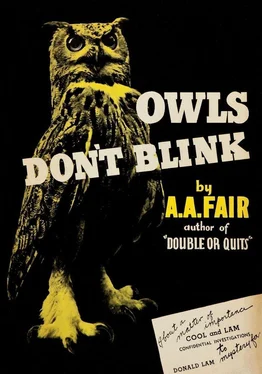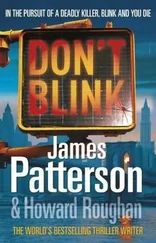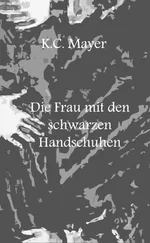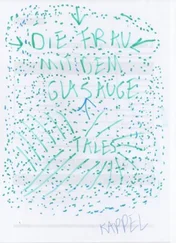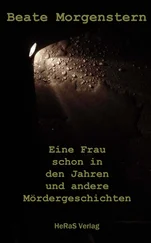I said, “We get off here and walk the rest of the way. It’ll take five minutes.”
Hale was very much interested in the furniture, and the old-fashioned, high-ceilinged rooms. He walked out onto the porch, looked around at the plants, looked up and down the street, came back, tried the bedspring with the palm of his hand, and said, “Very, very nice. I think I’ll be able to rest here. And so Roberta Fenn lived here — very, very interesting.”
I told him he’d better try to get some sleep, left him there, went out, and hunted up a telephone booth where I’d be assured of privacy.
It took me half an hour dealing over the phone with a detective agency in Little Rock to find out that 935 Turpitz Building, the address given in Edna Cutler’s letter to Roberta Fenn, had been a mailing address only. It was a big office where a girl rented out desk space to small businessmen, did stenographic work, and forwarded mail.
She would forward mail to Edna Cutler, but the actual address of her client was confidential — very much of a secret.
I told the Little Rock man the agency would send him a check, and then hunted up a commercial typing agency. I asked the girl in charge, “Could you make a stencil for me and run off a thousand letters on a mimeograph machine?”
“Why, certainly.”
“Got a stenographer I can dictate a sales letter to?”
The girl smiled at me, picked up her pencil. “The managing department now becomes the clerical unit. You can start whenever you’re ready.”
I said, “I’m ready. Here we go.”
I started dictating:
Dear Madam:
A close personal friend of yours says that you have pretty legs. You want them to look pretty, and ice want them to look pretty.
You can’t get the sheer hosiery which you could formerly buy — not if you try to buy in the United States.
It is quite possible, however, that exclusive arrangements could be made to supply you with sheer silk hosiery for the duration of the war. At the time of Pearl Harbor a Japanese ship put into a Mexican port and we were able to obtain its cargo of silk stockings originally destined for the United States. This hosiery would be shipped to you duty prepaid from Mexico City. All you’ll have to do will be to open the package, put on the stockings, and wear them for thirty days. If, at the end of those thirty days, you are entirely satisfied, make a remittance at the same price you were paying for hosiery a year ago. If any of the hose should develop runs or show signs of defective workmanship or of material, you need only to return such defective hose for a complete credit.
Simply place your name and address, the size, style, and color of sheer silk stocking you prefer to wear on the enclosed blank, put it in the enclosed, stamped, addressed envelope, drop it in the mail. You are not obligated in any way.
The girl looked up. “That all?”
“That’s all,” I said, “except that it will be signed Silk-wear Importation Company, and I’ll have to work out a color chart and order blank to enclose.”
“How many of these do you want?”
“A thousand. After you have the stencil made, I’d like to see one or two samples before we go ahead with the full thousand letters.”
She looked up at me, studying me. “All right. Now, what’s the racket?”
I just stared at her, saying nothing.
“Look — there was an embargo on silk a long time before Pearl Harbor, and when did stockings ever come from Japan?”
I grinned. “If the people who get these letters are as smart as you are, I’m out of luck. I’m a private detective. This is a stall. I’m trying to smoke someone out from behind a blind address.”
She looked me up and down. I could see the puzzled surprise in her eyes change to respect. She said, “Okay, you almost took me to the cleaners. So you’re a detective?”
“Yes, and don’t tell me I don’t look like one. I’m getting tired of hearing that.”
“It’s a business asset,” she announced. “You should be proud of it. All right, what’s the real dope on these? How many of them do you really want?”
“Just two. Don’t make too good a job of it. Smear them up a little as though out of a thousand copies these people were getting the last two. You can address the envelopes. The first is Edna Cutler, 935 Turpitz Building, Little Rock, Arkansas, and the other is Bertha Louise Cool, Drexel Building, Los Angeles.”
She laughed, swung the typewriter from the side compartment of her desk, and announced, “It’s a good gag. Come back in half an hour, and I’ll have ‘em ready.”
She fed the stencil sheet into her typewriter and started playing a tune on the keyboard.
I told her I’d be back, went out, bought an early afternoon paper, and sat down at the lunch counter to read the account of the murder.
As yet, the newspapers didn’t have all the details, but they had enough to hit the high spots. Paul G. Nostrander, a popular young attorney, had been found dead in the apartment of Roberta Fenn. Roberta Fenn was missing. Employed in a secretarial position in a downtown bank, she had failed to show up for work. An examination of her apartment convinced police that if she had fled, she had taken no clothes with her, not even her facial creams, toothbrush, or even her purse. The purse was lying unopened on the dresser in the bedroom. Not only did it contain her money, but her keys as well. Police reasoned, therefore, that she was entirely without funds, without means of re-entering her own apartment. They expected either to find her body sometime within the next twenty-four hours, or that she would voluntarily surrender to the police. Police inclined to two theories. One was that the murderer had killed the young attorney, then forced Roberta Fenn to accompany him at the point of a gun. The other was that the murder had taken place during Miss Fenn’s absence from her apartment, that she returned to find the body in much the same position as police had found it, and, in a panic, had resorted to flight. There was, of course, the third possibility, which was that Roberta Fenn had been the one who pulled the trigger on the gun.
Apparently police were inclined to give more credence to the first theory.
Police were making a diligent search for a young, well-dressed man wearing a gray checkered suit who had been waiting for Roberta Fenn when she finished her work at the bank the evening before. Witnesses had seen him escort her into a taxicab. Police had a good description: Height, 5 feet 5½ inches; weight, 130 pounds; hair, dark, wavy; eyes, gray and keen; age, 29; suit, gray, double-breasted; shoes, brown and white sport.
Nostrander had been practicing law for about five years. He was 33 years of age, and among lawyers was noted for his ingenuity as well as his mental agility in the trial of a case. He was a bachelor. Both parents were dead, but he had an older brother, 37, who was employed in an executive capacity with one of the bottling companies. So far as was known, the dead lawyer had no enemies, although he had a host of friends who were shocked to learn of his passing.
The crime had been committed with a .38 caliber police special. Only one shot had been fired, and only one shot had been needed. Doctors said death was almost instantaneous. The position of the body and the distance from the hand of the corpse to the gun which was found lying on the floor made it almost impossible to consider the death as other than deliberate murder. Police were also investigating the theory that the death might have been part of some strange suicide pact, that Roberta Fenn had become too nervous or frightened to carry out her part of the bargain, and so had disappeared.
Police fixed the time of the murder as being almost exactly at 2:32 in the morning. Because a pillow had been held over the gun, the report had been muffled. Only one person had actually heard the shot. That person, Marilyn Winton, a hostess at the Jack-O’-Lantern, had been returning home. She had the apartment directly across the hall from that of Miss Fenn. It had been just as she was fitting her latchkey to the street door to the apartment house that she had heard what she took to be a shot. Two friends, who had driven her home, were waiting at the curb to “see that she got in all right.” Miss Winton had immediately returned to their car to ask if either,of them had heard a shot. Neither had. Police attached some significance to this, as it indicated that the pillow had muffled the explosion sufficiently to make the single shot inaudible above the sound of the idling motor.
Читать дальше
